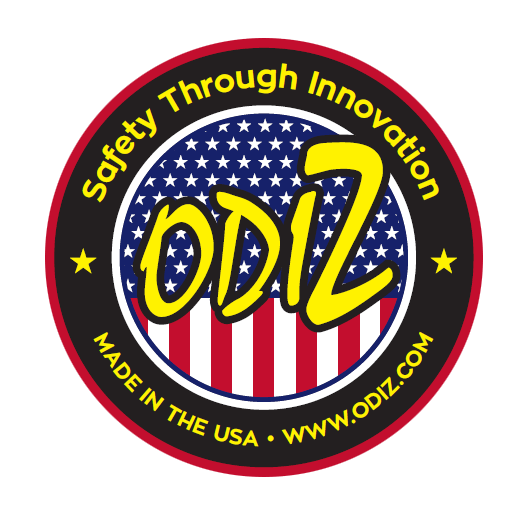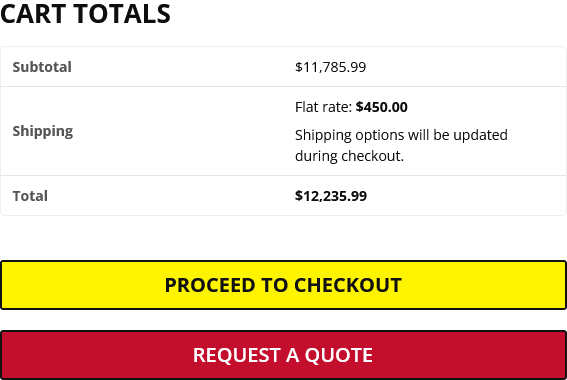Universal Tongue Guard Replacement (7-10″) W/Optional Eye Shield
$34.99 – $79.99
| Weight | 1.2 lbs |
|---|---|
| Dimensions | 2 × 2 × 3 in |
| Size | For 7-10" Grinder, 7-10" Grinder with Eye Shield |
| UPC | 736846909534 |
| Product Classification | Bench Grinder Tongue Guard/ Universal Bench Grinder Guard |
| Manufacturer | ODIZ |
The ODIZ Universal Tongue Guard Replacement (7–10″) restores OSHA compliance for larger grinders. Affordable, universal fit with optional heavy-duty eye shield and magnetic Allen wrench.
Not sure where to start? Reach out to our team to learn more.
To request more information about this product or service, please complete the form below. You can also chat live with one of our specialists via the widget in the bottom-right corner of your screen or call us at (574) 318-4333.
Product Overview
The ODIZ Universal Tongue Guard Replacement (7–10″) is a cost-effective solution for restoring OSHA 29 CFR 1910.215 compliance on larger bench grinders.
Instead of replacing the entire grinder, this universal kit allows you to replace missing, damaged, or obsolete tongue guards quickly and affordably.
Designed to fit most 7–10″ grinders, this kit helps facilities maintain compliance while protecting operators from debris and unsafe wheel exposure.
Why Replace Your Tongue Guard?
OSHA requires bench grinder tongue guards (upper guards) to be adjusted to within 1/4” of the wheel per OSHA 1910.215(a)(4).
Missing or damaged guards not only expose operators to serious hazards but are also among the most common grinder-related citations during OSHA inspections.
The ODIZ Universal Tongue Guard Kit ensures compliance and extends the life of your grinder without the cost of full replacement.
Kit Includes
- 1 Universal Tongue Guard Kit
- 1 Universal Tongue Guard Assembly Kit
- 1 ODIZ Magnetic Point-of-Use Allen Wrench
- 1 Heavy Duty Eye Shield (optional add-on)
Ordering Information
- For 7–10″ Bench Grinders (Item #: 55212)
- Each side sold individually — order 2 kits to replace both sides
- Custom made at time of order; ships within 2–3 business days
Key Benefits
- Restores OSHA-compliant grinder operation
- Affordable alternative to replacing the entire machine
- Universal fit for most 7–10″ bench grinders
- Includes magnetic Allen wrench for easy adjustments
- Optional heavy-duty eye shield for enhanced operator protection
1910.215 – Abrasive Wheel Machinery: Guarding and Safety Requirements
OSHA 1910.215 — Abrasive Wheel Machinery: Guarding and Safety Requirements
OSHA 29 CFR 1910.215 establishes critical safety standards for abrasive wheel machinery—equipment such as bench grinders, pedestal grinders, surface grinders, and cutoff wheels.
This section is designed to protect operators from hazards associated with wheel breakage, contact injuries, and flying fragments by requiring appropriate wheel guards, tool rest spacing, ring testing, and maintenance practices.
Abrasive wheel machinery operates at extremely high speeds, and failure to meet these safety requirements can result in catastrophic injuries or fatalities.
Purpose and Intent
The intent of OSHA 1910.215 is to ensure that all abrasive wheel machines are equipped with properly designed guards and safety devices to contain fragments if a wheel breaks and to minimize the risk of operator contact with rotating parts.
This regulation also standardizes wheel mounting procedures, speed limits, and inspection routines to ensure that each wheel operates within its rated capabilities.
Key Requirements
- Wheel guards: All abrasive wheels must be enclosed by guards that cover the spindle end, nut, and flange projections to protect against wheel fragments.
- Tool rests: Tool rests must be adjusted closely to the wheel (no more than 1/8 inch away) to prevent workpieces from being pulled between the wheel and the rest.
- Work rests: Must be secure, adjustable, and maintained in good condition to support material during grinding.
- Flanges: Each wheel must be properly mounted with flanges of equal diameter and strength to distribute clamping force evenly.
- Ring testing: All vitrified wheels must undergo a “ring test” before mounting to detect cracks or defects.
- Speed control: Machines must not operate at speeds exceeding the maximum safe operating speed (MSOS) marked on the wheel.
- Guard openings: The guard’s exposure angle must not exceed limits based on wheel type and mounting (bench, floor stand, cylindrical, etc.).
Types of Abrasive Wheel Machinery Covered
- Bench and pedestal grinders: Must have upper wheel guards enclosing at least 75% of the wheel periphery.
- Surface grinders: Require guarding of the periphery and sides not used for grinding.
- Cylindrical and centerless grinders: Must have fixed and adjustable guards enclosing the wheel and regulating rollers.
- Portable grinders: Require wheel guards covering at least 180° of the wheel.
- Cutoff machines: Must include a fixed hood-type guard covering the wheel and spindle.
Common Hazards Controlled
- Wheel explosion: Containment of high-speed fragments from cracked or overspeed wheels.
- Contact injuries: Prevents accidental hand or body contact with rotating abrasive surfaces.
- Kickback: Reduces rebound of material due to poor work rest positioning or improper guarding.
- Flying debris: Contains sparks, dust, and fragments during grinding operations.
- Vibration and imbalance: Ensures safe wheel mounting and alignment to prevent shaft or bearing damage.
Guarding and Spacing Requirements
- Tool rests must be within 1/8 inch of the wheel surface.
- Adjustable tongue guards (spark deflectors) must be set no more than 1/4 inch from the wheel periphery.
- Bench and floor grinders must have wheel exposure limited to 90° or less of the periphery.
- All guards must be constructed of steel or equivalent material to contain wheel fragments at maximum operating speed.
Wheel Mounting and Inspection Procedures
- Perform a ring test on vitrified wheels before mounting to detect internal cracks.
- Ensure wheel flanges are of equal diameter, flat, and free from burrs or distortion.
- Use blotters (compressible paper washers) between the wheel and flange where specified by the manufacturer.
- Never force a wheel onto a spindle or use excessive pressure during mounting.
- Run the wheel at operating speed in a protected area for at least one minute before use to confirm stability.
Maintenance and Operation
- Inspect wheels and guards before each shift for cracks, wear, and secure attachment.
- Maintain speed governors and motor controls to prevent overspeeding.
- Clean guards and housings regularly to prevent buildup of grinding dust.
- Replace worn or damaged guards immediately—do not weld or patch wheel guards.
- Ensure work rests are properly adjusted after each wheel dressing or replacement.
Best Practices for Compliance
- Install clear signage showing wheel speed limits and mounting instructions near each machine.
- Train operators in safe grinding practices, including ring testing, guard adjustment, and PPE use.
- Provide eye and face protection such as safety glasses and face shields for all operators.
- Incorporate lockout/tagout procedures for wheel changes and maintenance (per OSHA 1910.147).
- Use ANSI B7.1-compliant abrasive wheels that meet manufacturing and performance standards.
Why OSHA 1910.215 Is Important
OSHA 1910.215 is one of the most critical standards in machine guarding because it addresses the hazards of high-speed rotating abrasive wheels.
Improperly guarded or mounted wheels can explode with tremendous force, causing severe lacerations, blindness, or death.
By enforcing uniform requirements for guards, tool rests, and inspection procedures, this regulation ensures that abrasive wheel machinery operates safely within its design limits, protecting both operators and nearby workers.
Related Standards
- OSHA 1910.212: General requirements for all machine guarding.
- ANSI B7.1: Safety requirements for the use, care, and protection of abrasive wheels.
- OSHA 1910.243(c): Portable powered tool safety standards.
- OSHA 1910.219: Mechanical power-transmission apparatus standards.
FAQ
What is a ring test and why is it required?
The ring test detects cracks in vitrified wheels by lightly tapping the wheel and listening for a clear metallic ring sound. A dull tone indicates damage, and the wheel must not be used.
How close should the tool rest be to the wheel?
The tool rest must be adjusted to within 1/8 inch of the wheel to prevent workpieces from being wedged between the rest and the wheel.
Do portable grinders fall under OSHA 1910.215?
Yes. Portable grinders are covered and must have wheel guards that enclose at least 180 degrees of the wheel and are properly mounted.
1910.215(a) – General Requirements for Abrasive Wheel Machinery
OSHA 1910.215(a) — General Requirements for Abrasive Wheel Machinery
Paragraph (a) sets the baseline rules for using abrasive wheels: machines must have safety guards,
guards must be designed and fastened correctly, proper work rests are required on offhand grinders,
and some items are excluded from this section. Use this as the top-level guidance before drilling into
the subsection-specific requirements.
(a)(1) Machine guarding — When guards are required (and the limited exceptions)
Abrasive wheels may be used only on machines equipped with safety guards. Limited exceptions apply for:
- Internal work while the wheel is within the workpiece.
- Mounted wheels ≤ 2 in. diameter used in portable operations.
- Types 16, 17, 18, 18R, and 19 (cones, plugs, threaded-hole “pot balls”) when the work itself provides protection.
(a)(2) Guard design — What the guard must cover and how it’s secured
The guard must cover the spindle end, nut, and flange projections, stay aligned with the wheel, and be
secured so that the fastenings are stronger than the guard itself. Two narrow exceptions allow exposure of
the spindle end, nut, and outer flange where the work provides protection, and for portable saws.
(a)(3) Flanges — Cross-reference
Grinding machines must be equipped with flanges per §1910.215(c) (minimum diameters, types/exceptions, and mounting rules).
See your site’s child category for 1910.215(c) for the detailed tables and figures.
(a)(4) Work rests — Required on offhand grinders
- Use a rigid, adjustable rest to support the work.
- Keep the opening to the wheel at ≤ 1/8 in (3.2 mm) to prevent jamming and wheel breakage.
- Clamp after each adjustment; never adjust with the wheel in motion.
(a)(5) Excluded items
Natural sandstone wheels and metal/wooden/cloth/paper discs with abrasive layered on the surface are excluded from §1910.215.
Practical inspection cues (use for audits & training)
- Verify a guard is present unless one of the (a)(1) exceptions applies; document the exception if used.
- Confirm guard coverage encloses spindle end, nut, and flange projections and remains aligned during operation.
- Check that fasteners exceed guard strength (no loose, mismatched, or under-sized hardware).
- On bench/pedestal grinders, measure and record work-rest clearance ≤ 1/8″; re-adjust for wheel wear.
- Cross-check machine/wheel type against exclusions before applying §1910.215 requirements.
Link this category to:
- Your grinder guards, tongue guards, eye shields, and gap-gauge product pages.
- Child categories for 1910.215(b) (guarding specifics), 1910.215(c) (flanges), and 1910.215(d) (mounting/operation).
- Related categories: 1910.212 (general machine guarding), 1910 Subpart I (PPE).
FAQ
Do I ever run a grinder without a guard?
Only in the narrow cases listed in (a)(1): internal work within the part, mounted wheels ≤ 2″ in portable use,
and certain cone/plug types where the work itself protects the operator. Otherwise, a safety guard is required.
What exactly must the guard cover under (a)(2)?
The guard must cover the spindle end, nut, and flange projections, remain aligned with the wheel, and use
fasteners whose strength exceeds that of the guard. Limited exposure of these parts is allowed when the work
provides protection or for machines designed as portable saws.
How tight does the work rest need to be?
Keep the opening to ≤ 1/8″. Adjust for wheel wear and clamp securely; never adjust with the wheel running.







